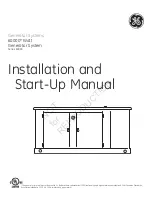
•
The shifting from one speed to the other must be performed by stopping shortly in the neutral position while
the engine is running at idle speed. A direct shifting from the forward speed to the reverse speed without
stopping in the neutral position is allowed only in case of emergency.
•
When the boat is sailing (engine stopped), the gear lever must be in neutral position; never put the gear
lever in the position corresponding to the direction of travel of the boat.
•
The clutch-unit is self-adjusting and, therefore, needs no adjustment.
•
If after using the reverse-gear unit for a long time, shifting (from forward speed to neutral or from reverse
speed to neutral) becomes particularly difficult, it is advisable first to check the status of the control cable
and of its relevant box and then, if necessary, unlock the nut ref. 35 (spanner 13) manteining the screw
ref.36 in its position with an allen wrench (4 mm.); rotate clockwise the screw ref. 36 by a ¼ of turn and
lock the nut ref. 35.
•
If one or both clutches slip, it is necessary to check if the control cable runs the whole stroke needed to
couple the reverse-gear unit (minimum 30 mm on each side in the lower hole and 35 mm on each side in the
upper hole of the control lever) and if the neutral position of the reverse-gear unit corresponds to that of the
control cable. If the problem persists, it is necessary to disassemble the reverse-gear unit in order to check
the status of clutch ref. 22. If the clutch shows signs of wear or burns on its cone-shaped surfaces or on the
groove, it must be replaced. The cone-shaped surface on gears ref. 17 and 24 must also be checked; such
surface must show no marks of burning or seizure ond no material deposits coming from the clutch cone
otherwise the gears must be replaced. In the case the clutch-unit alone is replaced, it is not cecessary to
disassemble adjusting shims ref. 48 and, therefore, bearings need not to be adjusted during assembly.
The gearbox is supplied without oil. Before the first start-up it must be filled up to the maximum level
marked on the dipsick. Use ATF oil.
Before to start the engine make sure that the gearbox is in neutral position.
The gearbox could only be shifted with the engine at idle speed. Avoiding that the gearbox or the
coupling may be demaged.
Disassembly and assembly of the gearbox or of its parts is to be made by specialized technicians only.
GEARBOX DISASSEMBLY
Disassembly and assembly of the gearbox or of its parts is to be made by specialized technicians only.
In order to completely disassemble the reverse-gear unit, operate as follows:
•
Remove the reverse-gear control unit by unscrewing M8 two nuts ref. 34 and extracting the whole unit
(control lever ref. 43, cover ref. 42, shaft ref. 40, guide shoe ref. 30, screw ref. 36) carefully avoiding to
drop guide shoe ref. 30 into the reverse-gear unit as it has no axial lock.
•
Remove output flange ref. 49 from the reverse-gear unit by unscrewing nut ref. 51 and by extracting the
flange from the shaft spline.
•
Loosen fastening screws ref. 18 located between the box and the cover and, while holding the reverse-gear
unit in a vertical position, gently, beat the head of output shaft ref. 13 with a copper hammer in order to
separate the box from the cover.
•
While the reverse-gear unit is open, remove input shaft ref. 9 together with bearing cones ref. 8, 11 and the
whole output shaft. Loosen screw ref. 33 which fastens the intermediate shaft to the reverse-gear cover and
remove the whole intermediate shaft.
•
In order to disassemble the clutch cone from the output shaft, extract all parts according to the following
sequence: bearing ref. 11 located on the flange side, spacer ref. 14, gear ref. 24, pin housing cage ref. 15,
bush ref. 25 spacer ref. 16 and clutch cone ref. 22.
•
In order to complete the disassembly of the output shaft remove nut ref. 12 and extract, in the following
order, bearing ref. 11, spacer ref. 14, gear ref. 17, pin housing cage ref. 16, bush ref. 25 and spacer ref. 16.
•
Spacers ref. 48 are located between cover ref. 53, 46 and bearing ref. 11.
•
Disassembly of intermediate gear rif. 21: unscrew ring nut ref. 23, extract gear ref. 21 towards the splined
side of shaft ref. 56. Together with the gear also one of bearings ref. 57, distance ring ref. 58 and stop ring
ref. 59 and the cup of the other bearing ref. 57 will come out.
































